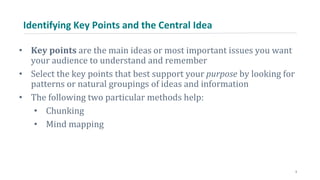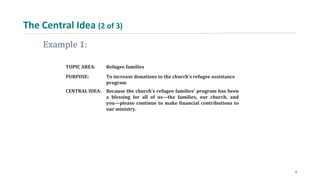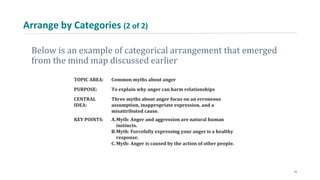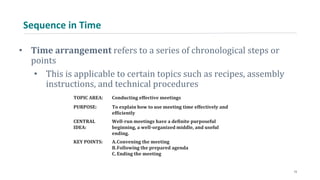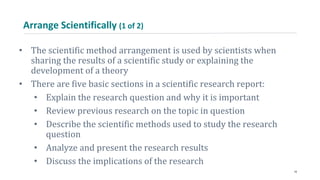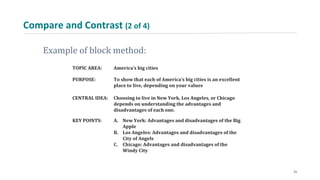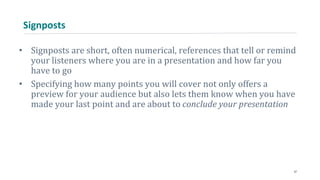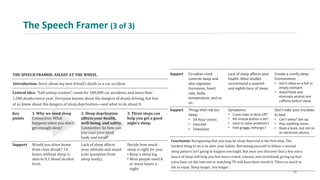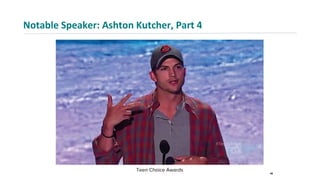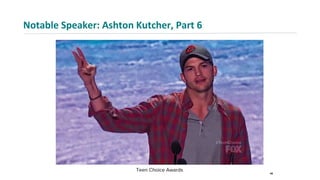Norton Field Guide for Speaking 3.3
- 1. Chapter 3.3 Organizing Content Copyright © 2022 W. W. Norton & Company
- 2. Introduction • The organization of a presentation is the arrangement of its content into a structured, coherent message • Organization puts the major components of your presentation in an appropriate order and keeps you focused on the development of each idea • Well-organized speakers are seen as more competent, confident, and persuasive than disorganized speakers • A well-organized presentation helps an audience clearly understand and make informed decisions about a speaker’s message, thus enabling the presentation to achieve its purpose 2
- 3. Identifying Key Points and the Central Idea • Key points are the main ideas or most important issues you want your audience to understand and remember • Select the key points that best support your purpose by looking for patterns or natural groupings of ideas and information • The following two particular methods help: • Chunking • Mind mapping 3
- 4. The Chunking Method • Chunking is the process of separately recording and strategically sorting the ideas and supporting material you’ve gathered so far • This simple method helps you identify your key points and allows you to arrange and rearrange them 4
- 6. Consider the Rule of Three • Communication experts agree that an effective presentation should offer at least two key points and no more than five • Three key points are often ideal • Keep in mind that this is a guideline, not an absolute, unbreakable rule, and depends on the rhetorical situation 6
- 7. The Central Idea (1 of 3) • Your purpose statement identifies the goal of your presentation • Your central idea summarizes your overall message and key points in one sentence • After your presentation, audience members should be able to remember and rephrase your central idea in their own words 7
- 8. The Central Idea (2 of 3) Example 1: TOPIC AREA: Refugee families PURPOSE: To increase donations to the church’s refugee assistance program CENTRAL IDEA: Because the church’s refugee families’ program has been a blessing for all of us—the families, our church, and you—please continue to make financial contributions to our ministry. 8
- 9. The Central Idea (3 of 3) Example 2: TOPIC AREA: Muzak PURPOSE: To make the audience more aware of the purpose and power of Muzak CENTRAL IDEA: The next time you hear Muzak playing, you will remember how pervasive it is, how it originated, and how it tries to lift your spirits and productivity. 9
- 10. Patterns of Organization • Generally, the nature of your topic, your purpose, and your key points will dictate the overall organization of your presentation • There are several commonly used organizational patterns that can help you find an appropriate arrangement for your presentation 10
- 11. Arrange by Categories (1 of 2) • Categorical arrangement divides a large topic into smaller categories within that topic TOPIC AREA: The Shakers PURPOSE: To appreciate the legacy of the Shaker religion in the United States CENTRAL IDEA: The Shaker religion is a unique American religious group with distinctive beliefs about Christian life and inventiveness as a productive community. KEY POINTS: A. Origin of the Shaker religion B. Core beliefs about the perfect Christian life 1.Communal living 2.Celibacy 3.Confession of sins C. Shaker inventions 1.Agriculture 2.Architecture and furniture 3.Tools 11
- 12. Arrange by Categories (2 of 2) Below is an example of categorical arrangement that emerged from the mind map discussed earlier TOPIC AREA: Common myths about anger PURPOSE: To explain why anger can harm relationships CENTRAL IDEA: Three myths about anger focus on an erroneous assumption, inappropriate expression, and a misattributed cause. KEY POINTS: A.Myth: Anger and aggression are natural human instincts. B.Myth: Forcefully expressing your anger is a healthy response. C. Myth: Anger is caused by the action of other people. 12
- 13. Sequence in Time • Time arrangement refers to a series of chronological steps or points • This is applicable to certain topics such as recipes, assembly instructions, and technical procedures TOPIC AREA: Conducting effective meetings PURPOSE: To explain how to use meeting time effectively and efficiently CENTRAL IDEA: Well-run meetings have a definite purposeful beginning, a well-organized middle, and useful ending. KEY POINTS: A.Convening the meeting B.Following the prepared agenda C. Ending the meeting 13
- 14. Position in Space • Space arrangement is used when your information can be placed in different locations TOPIC AREA: Brain structure PURPOSE: To explain how different sections of the brain are responsible for different functions CENTRAL IDEA: A guided tour of the brain begins in the hindbrain, moves through the midbrain, and ends in the forebrain, with side trips through the right and left hemispheres. KEY POINTS: A.The hindbrain B.The midbrain C. The forebrain D.The right and left hemispheres 14
- 15. Present Problems and Solutions (1 of 2) • Problem-solution arrangement describes a problem and offers a plan to solve the problem (the solution) • This pattern can be applied to both informative and persuasive presentations 15
- 16. Present Problems and Solutions (2 of 2) TOPIC AREA: Sitting, inactivity, and health PURPOSE: To recommend methods for reducing the aches and pains of sitting too long CENTRAL IDEA: Sitting for long periods of time can cause serious health problems, but standing up and moving around on a regular schedule can offset the harms. KEY POINTS: A. Extended sitting can be harmful to physical health. (Heart disease and cancer both increase with number of hours per day spent sitting.) B. A sedentary lifestyle increases the risk of certain mental health problems, such as depression and dementia. C. A regular schedule of simple physical activities (for example, standing up, walking, doing chores) significantly reduces health risks. 16
- 17. Show Causes and Effects (1 of 2) • A cause-and-effect arrangement either presents a cause and its resulting effect (cause-to-effect) or describes the effect that results from a specific cause (effect-to-cause) TOPIC AREA: Children and television PURPOSE: To describe how watching too much television causes harmful effects in children CENTRAL IDEA: Television harms children and their families because it steals time that could be spent on more important activities. KEY POINTS: A. Television has a negative effect on children’s physical fitness. B. Television has a negative effect on children’s school achievement. C. Television is a hidden competitor for more important activities. D. Television watching may become a serious addiction. 17
- 18. Show Causes and Effects (2 of 2) TOPIC AREA: Obesity PURPOSE: To understand why so many Americans are obese CENTRAL IDEA: Understanding five reasons why people are obese is the first step in combating its harmful effects. KEY POINTS: A. Effect: Obesity is a serious medical problem in the United States. B. Causes: 1.Hidden dangers in processed and fast foods 2.Lack of exercise 3.Psychological factors: anxiety, low self-esteem, excessive use of alcohol and tobacco 4.Family influence, habits, and lifestyle 5.Genetics 18
- 19. Arrange Scientifically (1 of 2) • The scientific method arrangement is used by scientists when sharing the results of a scientific study or explaining the development of a theory • There are five basic sections in a scientific research report: • Explain the research question and why it is important • Review previous research on the topic in question • Describe the scientific methods used to study the research question • Analyze and present the research results • Discuss the implications of the research 19
- 20. Arrange Scientifically (2 of 2) TOPIC AREA: Presentation anxiety and the preparation process PURPOSE: To explain why anxious speakers should study and master the process of preparing an effective presentation CENTRAL IDEA: Learning effective preparation skills can reduce your level of speech anxiety and improve the quality of your presentation. KEY POINTS: A. Research question: What is the relationship between speaker anxiety and preparation skills? B. Review previous research C. Describe the research method D. Present the research results E. Discuss the implications of the research: Learning effective preparation skills can reduce presentation anxiety. 20
- 21. Tell Stories and Give Examples • A series of memorable stories or examples can be compelling and interesting enough to become the backbone of a speech TOPIC AREA: Leaders and adversity PURPOSE: To convince listeners that disabilities are not a barrier to success CENTRAL IDEA: Many noteworthy leaders have lived exceptional lives with disabilities. KEY POINTS: A. Franklin D. Roosevelt, president of the United States, paralyzed by polio B. Jan Scruggs, wounded soldier and founder of the Vietnam Veterans Memorial Fund C. Helen Keller, deaf and blind author, lecturer, and disability advocate 21
- 22. Compare and Contrast (1 of 4) • A comparison-contrast arrangement shows your audience how individual things are similar to or different from each other • In the block method, you describe the relevant information about one item and then compare it to the relevant information about another item • In a point-by-point comparison, you focus on specific points of comparison between the things you are comparing • In a figurative analogy, something unfamiliar is compared with something more familiar, showing how two unrelated items have certain common characteristics 22
- 23. Compare and Contrast (2 of 4) Example of block method: TOPIC AREA: America’s big cities PURPOSE: To show that each of America’s big cities is an excellent place to live, depending on your values CENTRAL IDEA: Choosing to live in New York, Los Angeles, or Chicago depends on understanding the advantages and disadvantages of each one. KEY POINTS: A. New York: Advantages and disadvantages of the Big Apple B. Los Angeles: Advantages and disadvantages of the City of Angels C. Chicago: Advantages and disadvantages of the Windy City 23
- 24. Compare and Contrast (3 of 4) Example of point-by-point comparison: TOPIC AREA: Family sedans PURPOSE: To recommend a way of evaluating medium-size cars CENTRAL IDEA: Comparing performance, comfort, fuel economy, and reliability can help you select and purchase a new midsize car for your family. KEY POINTS: A.Performance B.Comfort C. Fuel economy D.Reliability 24
- 25. Compare and Contrast (4 of 4) Example of figurative analogy: TOPIC AREA: Student success in college PURPOSE: To identify the multiple factors that affect student success in college CENTRAL IDEA: Predicting student success is like picking the winning horse at the racetrack and must include considerations of a student’s high school record, teachers, advisers, parents’ education, and the college environment. KEY POINTS: A.High school grades and test scores = Track record B.Parents’ education = Horse’s breeding record C. Teacher and adviser = Trainer and jockey D.College environment = Track conditions, length of race, and so on 25
- 26. Use Memory Aids Speakers can use easily remembered letters, words, or phrases to organize their speech to help their audience follow along and later remember their key points TOPIC AREA: Organizing a presentation PURPOSE: To provide an effective method for developing the key points of a presentation CENTRAL IDEA: The four Rs represent a series of critical thinking steps— review, reduce, regroup, refine—for generating a presentation’s key point. KEY POINTS: A.Review B.Reduce C. Regroup D.Refine 26
- 27. Other Organizational Patterns • There are additional patterns for various professions and special occasions, and several organizational patterns best suited for persuasive speaking • Depending on the rhetorical situation, audience characteristics, your credibility and purpose, and the topic area, you may be able to adapt a common pattern or invent one of your own • A creative organizational pattern can also enhance your credibility and boost your audience’s interest 27
- 28. Sequencing Key Points • In the arrangements that don't dictate the order, the following general considerations can help you decide the sequence of the key points: • Strength and Familiarity, • Audience, • Logistics. 28
- 29. Strength and Familiarity If one of your points is not as strong as the others or is less familiar to your audience, place it in the middle position 29
- 30. Audience • Consider your audience’s needs and motivations when deciding on the order of your key points • If the audience is familiar with and interested in your topic, begin with the strongest point • If the audience is unfamiliar with your topic, you are better off beginning with a point that explains why understanding the topic is important and then build up to your strongest point at the end 30
- 31. Logistics • The logistics of a speaking situation can sometimes affect the order of key points • If you’re one of a series of presenters, you may end up with less time to speak than was originally scheduled, and you should organize your presentation so that the most important key points come first • If the facility is not conducive to using presentation aids, you may have to change the order of your key points or even delete one that is highly dependent on a set of graphs 31
- 32. Connecting Key Points • Connectives link one part of a presentation to another, clarify how one idea relates to another, and identify how supporting material bolsters a key point • There are four kinds of connective phrases: • Internal Previews • Internal Summaries • Transitional Phrases • Signposts 32
- 33. Internal Previews • An internal preview reveals or suggests your key points to the audience in the introduction of the presentation • In the body of a speech, an internal preview describes how you are going to approach a key point How do researchers and doctors explain obesity? Some offer genetic explanations while others identify psychological ones. Either or both factors can be responsible for our never-ending battle with the bathroom scale. Let’s begin by looking at . . . 33
- 34. Internal Summaries • An internal summary ends a section and helps reinforce important ideas • Internal summaries also give you an opportunity to pause in a presentation and repeat critical ideas or pieces of information So remember, before spending hundreds of dollars on diet books and exercise equipment, make sure that your weight problem is not influenced by your hormone levels, your metabolism, or the amount of glucose in your bloodstream. 34
- 35. Transitions (1 of 2) • Transitions help you lead your audience from one key point or section to another • Some common transitions include: • Yet it’s important to remember . . . • In addition to metabolism, there is . . . • On the other hand, some people believe . . . • Another reason why he should be elected is . . . • Finally, a responsible parent should . . . 35
- 36. Transitions (2 of 2) • Transitions can also function as mini-previews and mini- summaries that link the conclusion of one section to the beginning of another • Bridge words alert listeners you are moving to a new thought • Trigger transitions use the same word or phrase twice to connect one topic to another • Questions shift the audience’s attention from one point to another • Flashbacks link a previous point to a new one • Delivery transitions use movement, gestures, or visual aids to signal a transition from one thing to another 36
- 37. Signposts • Signposts are short, often numerical, references that tell or remind your listeners where you are in a presentation and how far you have to go • Specifying how many points you will cover not only offers a preview for your audience but also lets them know when you have made your last point and are about to conclude your presentation 37
- 38. Constructing Your Presentation • Once you’ve identified your topic, purpose, central idea, key points, and supporting material, and once you’ve thought critically about the best organizing pattern and order for everything, you have the pieces you need to construct an effective, well-organized presentation • Two methods can help you build a complete blueprint or substantial structure for your presentation: • Outlining • Speech Framer 38
- 39. Outlining • Outlining organizes ideas in a specific order and uses formatting conventions to indicate the relative importance of, and the relationships among, those ideas • A preliminary outline helps you develop and arrange your key points and supporting material into a sketch of your presentation • A full-sentence outline gives you a comprehensive overview of your presentation • Speaking notes outline guides you through your presentation as you speak 39
- 40. The Speech Framer (1 of 3) • The speech framer is a visual framework that identifies a place for every component of a presentation • It also: • Makes it easier to modify, add, and delete content on a single page • Encourages experimentation, originality, and creativity • Is easily transformed into a complete outline, if necessary • Serves as efficient and flexible speaking notes 40
- 41. The Speech Framer (2 of 3) Introduction Central idea Key points 1. Connect to 2. 2. Connect to 3. 3. Support Support Support Conclusion 41
- 42. The Speech Framer (3 of 3) THE SPEECH FRAMER: ASLEEP AT THE WHEEL Introduction: Story about my best friend’s death in a car accident Central idea: “Fall-asleep crashes” count for 100,000 car accidents and more than 1,500 deaths every year. Everyone knows about the dangers of drunk driving, but few of us know about the dangers of sleep deprivation—and what to do about it. Key points 1. Why we need sleep Connective: What happens when you don’t get enough sleep? 2. Sleep deprivation affects your health, well-being, and safety. Connective: So how can you ease your tired body and mind? 3. Three steps can help you get a good night’s sleep. Support Would you drive home from class drunk? 14 hours without sleep is akin to 0.1 blood alcohol level. Lack of sleep affects your attitude and mood (cite quotation from sleep study). Decide how much sleep is right for you: • Keep a sleep log. • Most people need 8 or more hours a night. Support Circadian clock controls sleep and also regulates hormones, heart rate, body temperature, and so on. Lack of sleep affects your health. Most studies recommend a seventh and eighth hour of sleep. Create a comfy sleep Environment • Don’t sleep on a full or empty stomach. • Avoid fluids and eliminate alcohol and caffeine before sleep. Support Things that rob our sleep: • 24-hour stores • Internet • Television Symptoms: • Crave naps or doze off? • Hit snooze button a lot? • Hard to solve problems? • Feel groggy, lethargic? Don’t take your troubles to bed. • Can’t sleep? Get up. • Play soothing music. • Read a book, but not on an electronic device. Conclusion: Recognizing that you may be sleep deprived is the first step. The hardest thing to do is to alter your habits. Retraining yourself to follow a normal sleep pattern isn’t going to happen overnight. But once you discover that a few extra hours of sleep will help you feel more rested, relaxed, and revitalized, giving up that extra hour on the internet or watching TV will have been worth it. There so much in life to enjoy. Sleep longer, live longer. 42
- 43. Notable Speaker: Ashton Kutcher, Part 1 After being discovered by a talent agent in college, Ashton Kutcher began his career as a model. He transitioned into acting when he landed the part of Kelso on the television sitcom That ’70s Show. Perhaps his most significant role as a dramatic actor came in 2012 when he was cast as Steve Jobs in the biopic Jobs. His work outside the industry includes cofounding Thorn, an organization devoted to stopping human trafficking and the sexual exploitation of children. In 2013, Kutcher was the recipient of MTV’s Ultimate Choice Award at the annual Teen Choice Awards ceremony. The awards honor various achievements in fashion, television, film, and music, among other areas, and are voted on by viewers aged thirteen and over. Kutcher was thirty-five when he received the award.
- 44. Notable Speaker: Ashton Kutcher, Part 2 44
- 45. Notable Speaker: Ashton Kutcher, Part 3 45
- 46. Notable Speaker: Ashton Kutcher, Part 4 46
- 47. Notable Speaker: Ashton Kutcher, Part 5 47
- 48. Notable Speaker: Ashton Kutcher, Part 6 48
- 49. Conclusion • Clear and coherent organization is among the most important things your presentation needs in order to be effective • A coherent organizational structure helps you develop compelling and relevant key points that support your central idea in a way that enhances your audience’s understanding and interest 49
- 50. Credits This concludes the Lecture PowerPoint presentation for Chapter 3.3. For more resources, please visit The Norton Field Guide to Speaking: http://digital.wwnorton.com/nfgspeaking. Copyright © 2022 W. W. Norton & Company
Editor's Notes
- Photo credit: Courtesy of Isa Engleberg
- Search Terms To locate a video of this presentation online, enter the following key words into a search engine: Ashton Kutcher Teen Choice Awards. The video is approximately 4:41 in length. Photo credit: Everett Collection Inc./Alamy Stock Photo
- What to Watch For [0:26 –1:40] Using a comfortable conversational style, Kutcher demonstrates that he has analyzed his audience, purpose, and content in order to make strategic choices about what to say and how to say it. He uses lessons he has learned in life to inspire his audience to work hard, be kind, and build a life (his purpose). His focus on life lessons is appropriate for a young audience who could benefit from his experiences. Photo credit: Teen Choice Awards
- What to Watch For [1:00–1:45] As he begins to lay out his purpose, Kutcher says he’ll share some “insider secrets” with his audience about how to build a career in Hollywood. Then he says something that surprises his listeners (we can tell because they quiet down considerably after he says it): “I feel like a fraud. My name is actually not even Ashton. Ashton is my middle name. My first name’s Chris.” By doing this, he captures his audience’s attention and signals that his purpose will connect who he was as Chris to who he is now as Ashton. “There were some really amazing things that I learned as Chris,” he says, and he wants to share these things with his audience. This important and unexpected pivot provides a direct transition to the first of three key points Kutcher will make in the remainderof his acceptance speech. Photo credit: Teen Choice Awards
- What to Watch For [1:45–2:00] He organizes his presentation into three distinct key points. “The first thing is about opportunity,” he says, “the second thing is about being sexy, and the third thing is about living life.” The simplicity and clarity of the organization improves his audience’s ability to retain his central idea and key points, as well as the most relevant examples he uses to support his claims. Photo credit: Teen Choice Awards
- What to Watch For [2:48–3:32] Using a categorical arrangement pattern, Kutcher makes three key points (the rule of three). His second point about being sexy draws screams and cheers from the teenage audience. In an unexpected turn, he confides that being sexy has nothing to do with what they look like but everything to do with being smart, kind, and generous. The audience cheers louder as he encourages them not to buy into messages that make them feel “less than” based on how they look. Photo credit: Teen Choice Awards
- What to Watch For [3:32–3:40] To reinforce his second main point, Kutcher uses an internal summary to repeat those ideas. He summarizes: “Be smart. Be thoughtful. Be generous.” As he moves on to his next point, Kutcher uses a signpost to remind the audience where he is in the presentation. In this instance, he uses a numerical reference at the outset of the point: “The third thing . . .” His third point is tied to his most recent accomplishment— making the film about Steve Jobs. This point reinforces the connections between lessons he learned as Chris and where he is now as Ashton. Photo credit: Teen Choice Awards



